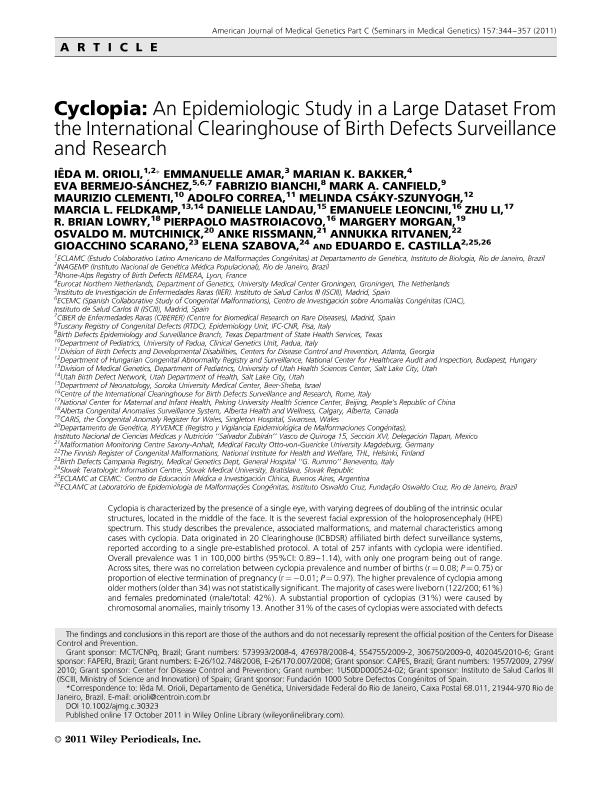Artículo
Cyclopia: An epidemiologic study in a large dataset from the International Clearinghouse of Birth Defects Surveillance and Research
Orioli, Ieda Maria; Amar, Emmanuelle; Bakker, Marian K.; Bermejo Sánchez, Eva; Bianchi, Fabrizio; Canfield, Mark A.; Clementi, Maurizio; Correa, Adolfo; Csáky Szunyogh, Melinda; Feldkamp, Marcia L.; Landau, Danielle; Leoncini, Emanuele; Li, Zhu; Lowry, R. Brian; Mastroiacovo, Pierpaolo; Morgan, Margery; Mutchinick, Osvaldo M.; Rissmann, Anke; Ritvanen, Annukka; Scarano, Gioacchino; Szabova, Elena; Castilla, Eduardo Enrique

Fecha de publicación:
08/2011
Editorial:
Wiley-liss, div John Wiley & Sons Inc.
Revista:
American Journal Of Medical Genetics Part C-seminars In Medical Genetics
ISSN:
1552-4868
Idioma:
Inglés
Tipo de recurso:
Artículo publicado
Clasificación temática:
Resumen
Cyclopia is characterized by the presence of a single eye, with varying degrees of doubling of the intrinsic ocular structures, located in the middle of the face. It is the severest facial expression of the holoprosencephaly (HPE) spectrum. This study describes the prevalence, associated malformations, and maternal characteristics among cases with cyclopia. Data originated in 20 Clearinghouse (ICBDSR) affiliated birth defect surveillance systems, reported according to a single pre-established protocol. A total of 257 infants with cyclopia were identified. Overall prevalence was 1 in 100,000 births (95%CI: 0.89-1.14), with only one program being out of range. Across sites, there was no correlation between cyclopia prevalence and number of births (r=0.08; P=0.75) or proportion of elective termination of pregnancy (r=-0.01; P=0.97). The higher prevalence of cyclopia among older mothers (older than 34) was not statistically significant. The majority of cases were liveborn (122/200; 61%) and females predominated (male/total: 42%). A substantial proportion of cyclopias (31%) were caused by chromosomal anomalies, mainly trisomy 13. Another 31% of the cases of cyclopias were associated with defects not typically related to HPE, with more hydrocephalus, heterotaxia defects, neural tube defects, and preaxial reduction defects than the chromosomal group, suggesting the presence of ciliopathies or other unrecognized syndromes. Cyclopia is a very rare defect without much variability in prevalence by geographic location. The heterogeneous etiology with a high prevalence of chromosomal abnormalities, and female predominance in HPE, were confirmed, but no effect of increased maternal age or association with twinning was observed.
Archivos asociados
Licencia
Identificadores
Colecciones
Articulos(SEDE CENTRAL)
Articulos de SEDE CENTRAL
Articulos de SEDE CENTRAL
Citación
Orioli, Ieda Maria; Amar, Emmanuelle; Bakker, Marian K.; Bermejo Sánchez, Eva; Bianchi, Fabrizio; et al.; Cyclopia: An epidemiologic study in a large dataset from the International Clearinghouse of Birth Defects Surveillance and Research; Wiley-liss, div John Wiley & Sons Inc.; American Journal Of Medical Genetics Part C-seminars In Medical Genetics; 157; 4; 8-2011; 344-357
Compartir
Altmétricas



